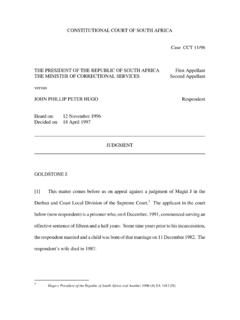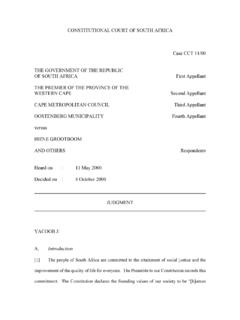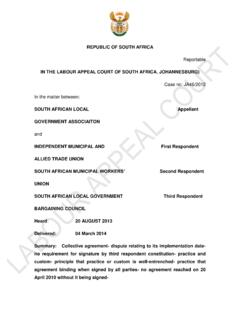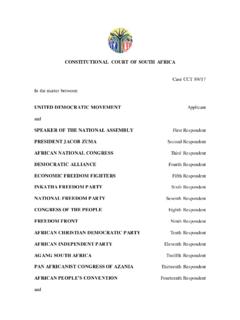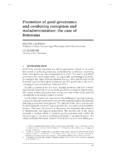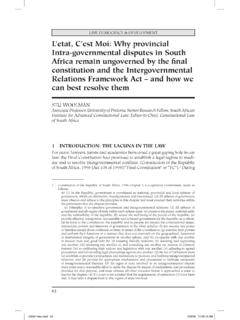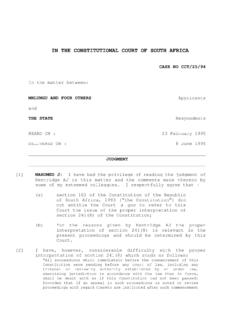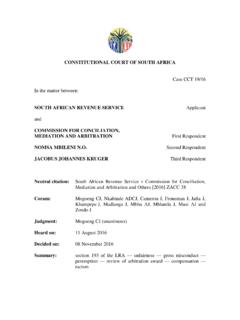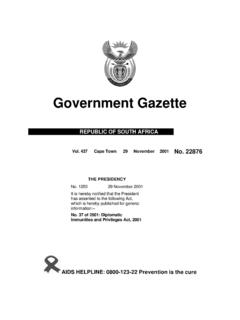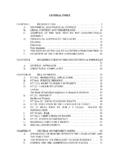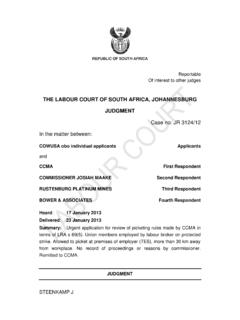Transcription of REPUBLIC OF SOUTH AFRICA - SAFLII
1 REPUBLIC OF SOUTH AFRICA . IN THE HIGH COURT OF SOUTH AFRICA . GAUTENG LOCAL DIVISION, JOHANNESBURG. CASE NO: A263/2016. (,) REPORT ABLE:Q. (:L) OF INTEREST (3) .L~.z;.[~?. n .. ~ .. J.~. UR;- -o )J. DATE SIGN. In the matter between: YG appellant and THE STATE Respondent together with THE CHILDREN'S INSTITUTE First Amicus Curiae THE QUAKER PEACE CENTRE Second Amicus Curiae SONKE GENDER JUSTICE Third Amicus Curiae FREEDOM OF RELIGION SOUTH AFRICA Fourth Amicus Curiae JUDGMENT. KEIGHTLEY, J: INTRODUCTION. [1] The appellant in this matter was tried in the Regional Court, Johannesburg, on two charges of assault with intent to do grievous bodily harm. The first charge related to his alleged assault of his 13-year old son, M, and the second charge related to his alleged assault of his wife. The two assaults were alleged to have occurred at the family home on the same day, although they occurred at different times. [2] The trial court found the appellant guilty on both charges on the competent verdict of common assault.]
2 The court invoked section 297(1 )(a)(ii) of the Criminal Procedure Act 51 of 1977, and postponed the passing of sentence against the appellant for a period of five years. The magistrate granted the appellant leave to appeal against his convictions. [3] As far as the facts relating to the first charge are concerned, it is common cause that on the day of the incident M was sitting on his parents' bed in their bedroom using one of the family's iPads. The appellant entered the room and accused M of watching pornographic material on the iPad. M denied this, but the appellant persisted with the accusation. There was a verbal exchange between them, with the appellant insisting that M should tell him the truth. When M repeated his denial the appellant hit him. He told M that he was lying, and he said that he was giving him another opportunity to tell the truth. When M refused to admit he was lying, the appellant hit him again. This pattern repeated itself a number of times.
3 2. [4] The appellant 's defence at the trial was that he had done nothing more than to exercise his right as a parent to chastise M by meting out reasonable corporal punishment for M's indiscipline. He told the court that they are a Muslim family and that M knew that pornography is strictly forbidden. [5] Certain important details of the incident are disputed. M testified that the appellant punched him with his fists on M's thighs. He also punched him on the chest. At this point M lost his balance and fell off the bed onto the floor and hit his back against the security gate, but his back was not really injured by the fall. While he was on the floor, the appellant kicked him three or four times with his bare foot. M was very sore. He was crying and he was emotional. He also testified that the appellant was very angry during the incident. [6] The appellant 's version was that he had only slapped M with an open hand on his buttocks.
4 He did not dispute that this happened a number of times after M repeatedly denied that he was lying. He testified that on one occasion he might have hit M on the back of the thighs but this happened when M tried to twist away from the appellant 's blows to his buttocks. As the appellant described his conduct, he had given M a spanking on the buttocks. He had done this because he was disappointed in M's conduct in watching pornographic material, which is forbidden in their religion, and for lying to the appellant about this. The appellant claimed that he did not intend to assault M. He said that: "I just intended(ed) to discipline him (M) out of concern to show him in the future what is right and what is wrong.". 3. [7] M was examined by a medical doctor 4 days after the incident took place. Dr van der Poel's clinical findings were recorded on the J88 form, and confirmed by him at the trial. He found a tender, slight swelling on the left side of the chest, and a tender left scapular.
5 There were two blue bruises on the upper lateral part of the right leg, and several blue bruises on the upper lateral part of the left leg. The J88 form indicates that the leg bruises were in the thigh region. Dr van der Poel testified that the injuries were consistent with an assault. However, he did not hesitate under cross-examination to confirm that the tenderness and swelling on the chest area could have been caused by something else, such as a soccer ball. He described the amount of force required to cause the injuries as medium, rather then severe or slight. He was asked under cross-examination whether the injuries could have been caused by a hiding with an open hand. To this Dr van der Poe! responded as follows: "Your worship, no. I do not think .. not the legs, not the bruises .. Because then we would have bigger areas of bruises and it would be bigger areas and it was not that big areas. It was more (round) areas." 1.
6 [8] According to Dr van der Poe!, swellings usually take between 5-7 days to go down, but discolouration usually takes longer. [9] The trial court found that the probabilities favoured the appellant 's version on the question of whether or not his son, M, had been viewing pornographic material on the iPad. However, the court went on to find that M's untruthfulness on this aspect of his evidence should not be overemphasised, Record, pg 112, lines 10-14. 4. and that it did not taint the remainder of M's evidence. The trial court went on to accept M's version of the assault on M, and to reject that of the appellant . [10] As regards the assault on his wife, Ms G, the trial court also rejected the appellant 's version. I will deal with the merits of the appeal against the appellant 's convictions in respect of both counts in due course. First, however, it is necessary to deal with an issue raised by this court when it considered the appeal.
7 That issue concerns the question of whether the defence of moderate chastisement to a charge of assault, which is based on the common-law right of a parent to inflict corporal punishment on his or her children, is compatible with the Constitution. As I have already indicated, this was the defence raised by the appellant against the charge of assault in respect of M. [11] This court requested counsel for both the appellant and the State to make submissions on the issue. In addition, we issued directions inviting any interested parties to be joined as amici of the court and to make submissions. In particular, we invited submissions from the Minister of Justice and Correctional Services, and the Minister of Social Development. The former Minister did not respond to the invitation, but we received written submissions on behalf of the Minister of Social Development, for which we are grateful. [12] Apart from the Minister of Social Development, we admitted four amici curiae to the proceedings.
8 They made both written and oral submissions. The first three amici were represented by the Centre for Child Law, and made joint 5. submissions. They were the Children's Institute, the Quaker Peace Centre, and Sonke Gender Justice. For simplicity's sake, I refer to them collectively as "the CCL amici". The fourth amicus was Freedom of Religion SOUTH AFRICA ("FORSA"). THE AMICI CURIAE. [13) The Children's Institute was established at the University of Cape Town in 2001. It's mission is to contribute to the development of policies, laws and services that promote equality and realise the rights and improve the conditions of all children in SOUTH AFRICA , through research, advocacy, education and technical support. One of the focuses of its work is the high rate of violence and abuse of children in SOUTH AFRICA . [14] The Quaker Peace Centre ("the QPC") was founded in 1987 by the Western Cape Religious Society of Friends (Quakers) in response to the repressive policies of apartheid and the need for developing non-violent methods of problem-solving, interaction and conflict resolution in SOUTH African society.]
9 Among other things, the QPC works with young parents providing support to, information on and skills for implementing positive and non-violent discipline of children. [15] Sonke Gender Justice supports the development of just and democratic societies through equitable, healthy and happy relationships between men, women and children. It works to promote gender equality and to prevent domestic and sexual violence. One of Sonke's portfolios is entitled Child Rights and Positive Parenting, which is aimed at working to end violence against children and to promote child-rights and gender-equitable, non- 6. violent and positive parenting. Among other things, Sonke has worked with the Positive Discipline Working Group towards achieving an amendment to the Children's Act to establish a full ban on corporal punishment of children, including in the home. [16] Not surprisingly, the CCL amici submitted that the common-law defence of reasonable chastisement is inconsistent with the Constitution.
10 They submitted that this court should develop the common law by declaring that this defence is no longer applicable. In addition to their legal submissions, the CCL filed an expert opinion in the form of an affidavit by the Director of the Children's Institute, Prof Shanaaz Mathews, covering the linkages between corporal punishment and violence against children. [17] FORSA is a non-profit company with the objective of engaging in advancing freedom of religion in SOUTH AFRICA through public awareness and research. They aver that they have an endorsement base of religious leaders representing more than 6 million people in SOUTH AFRICA , spanning various denominations, churches and faith groups. FORSA explains that its interest in the matter lies in that millions of believers believe that the scriptures command reasonable and appropriate correction of their children. Thus, for millions of believers, child correction, including physical chastisement at times, is a central to their faith.
